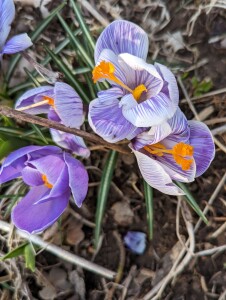 As St. Patrick’s Day approaches every year, people start to talk about “the wearing of the green”. Individuals who eschew green clothing and accessories 364 days a year, paw through drawers and closets to find green apparel or jewelry to wear in honor of the patron saint of Ireland. They also eat the green, as in green bagels and the green cabbage that sits next to big helpings of St. Patrick’s Day corned beef. Clearly there is enough “green” to go all around.
As St. Patrick’s Day approaches every year, people start to talk about “the wearing of the green”. Individuals who eschew green clothing and accessories 364 days a year, paw through drawers and closets to find green apparel or jewelry to wear in honor of the patron saint of Ireland. They also eat the green, as in green bagels and the green cabbage that sits next to big helpings of St. Patrick’s Day corned beef. Clearly there is enough “green” to go all around.
At this time of the year, “in the green” means something else to me—increasing my supplies of early spring-flowering plants like snowdrops, winter aconite and crocuses. All can be grown from fall-planted bulbs, but they tend to succeed the most readily when the plants are lifted and divided at the end of the bloom cycle. It is easy and satisfying to do if you yearn to fill your garden with even more early spring-flowering plants.
The most obvious reason for digging in the still-chilly earth is that you can see what you are doing. Horticulturists refer to these early-flowering species as “spring ephemerals,” meaning that they spring up through the cold earth, flower gloriously, produce leaves that photosynthesize and strengthening the bulbs, and then die back completely by the summer. If you dig and divide while the leaves are still present, there is less risk that you will dig in the wrong place.
That said, make sure you mark the spots where the divisions have been installed. You can also do this by taking pictures of the sites with your phone or camera.
Another benefit of spring propagation is that the plants are still in the active growth phase. When you replant the new divisions, they will have plenty of time to get established and start the rejuvenation process that will culminate in next year’s flower display. Think of it as getting a head start on next year’s garden while you are still thinking about what to plant for summer.
Lifting and dividing is easy because the small bulbs are not very deeply imbedded in the earth. Dig carefully around the clumps with a trowel or garden knife and lift the entire clump out. Divide it carefully just the way you would section a pie or cake, avoiding slicing into individual bulbs. Don’t be afraid of hurting the plants; they are amazingly resilient. Replant the divisions so that they are level with the surface of the surrounding soil. Firm the soil around the divisions and water well. You can then forget them, as the plants go about their business.
I have a lot of medium purple Crocus tommasinianus, known to most gardeners as “Tommie” crocuses. They are incredibly prolific left to their own devices, but I intend to help them along this year by dividing the clumps. In years past the local squirrel population has done this job through random digging and burying. Frankly, the squirrels generally lack an aesthetic sensibility, and I think I can do better. They will still dig, and I will still find “Tommies” that have mysteriously jumped from one side of the yard to the other, but overall the plantings will be a bit more intentional.
In my garden I have built a snowdrop collection over many years. Some of those snowdrop varieties are still on the market—though on a limited basis—but some are not. The only way to increase my supply of ‘Lady Elphinstone’ is to spread her around so that her lovely yellow ovaries and beautiful white petals are on wider display. I will get to the snowdrops right after I take care of the “Tommie” crocuses.
About ten years ago, my snowdrop vendor gave me a couple of bonus bulbs of winter aconite or Eranthis ‘Orange Glow’. These little buttercup-like flowers are not actually orange, but the petals are bright gold with an orange overtone. The individual flowers are surrounded by green ruffs of ferny foliage, making for a winsome presence. They are multiplying well in front of a hydrangea shrub. I think I want to increase that effect by dividing the ‘Orange Glow’ clumps and replanting them in front of other hydrangeas. Repetition makes great practical and aesthetic sense—except when squirrels do it.
I like getting close to the earth at this time of year to see the hungry bees swoop into the crocuses, and make futile attempts to prevent the onion grass from making its annual attempt at garden domination. The violets pop up everywhere, and their purple faces make me happy. Dividing the spring-flowering plants is good for the soul.
